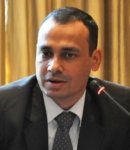Terrorism in South Asia
Sri Lanka Terror Strikes: What Next?
29 Apr, 2019 · 5583
Dr Bibhu Prasad Routray traces the big picture issues Sri Lanka will have to consider and address in the wake of the Easter Sunday bombings in the country
Under the nose of a state that
took peace for granted, members of two lesser-known radical organizations and sons
of a millionaire spice trader conspired to carry out a mass carnage on Easter Sunday
in Sri Lanka, an attack which has now been described as a reaction to the March
2019 attacks on two churches in New Zealand by a white supremacist. These radicals
had pledged their allegiance to the Islamic State, identified suicide bombers,
assembled suicide vests, and carried out synchronised attacks in multiple
locations including churches and hotels with the intent of killing Christians.
The attacks left 253 (according to revised estimates by the Sri Lankan
authorities) people dead and a nation in shock.
Much of the focus in the
aftermath of the attacks has been on the intelligence failure and the
phenomenon of expanding radicalism. The wife of a suicide bomber, who herself
had pledged baya’ah to the Islamic
State, blew herself up, killing her unborn child and three other children, as the
police forces raided their home. While investigation in the coming days and
months may reveal some of the details of the preparations leading to the attack,
whether that will prevent the next attack by Islamist radicals, is a bigger
question.
Available profiles of eight of
the nine suicide bombers involved in the attack reveal the usual trend that the
foot soldiers of the Islamic State have come to be associated with since 2014. Many
of them have been educated, a mix of middle-class and wealthy family members, and
are highly radicalised who either teamed up or were influenced by the
ideologues of the Islamic State to carry out mayhem. Such acts have been
perpetrated in many countries in past years, with varying degrees of ‘success’.
The ‘mastermind’ behind the
attacks in Sri Lanka, preacher Zahran Hashim, had gone into hiding in 2017,
after being accused by the police of causing violence between Muslim groups. One
of the two brothers, Inshaf Ibrahim owned Colossus Copper, a manufacturing
facility in an industrial estate in Colombo’s east. The factory, investigators
believe, was used to assemble the suicide vests used in the attack. Inshaf’s
brother Ilham had well known connections to National Thowheed Jamath (NTJ), a
Sri Lankan Islamist group suspected of involvement in planning the attacks. Abdul
Lathief Jameel, who failed in his task of carrying out an explosion at Colombo’s
Taj Samudra hotel and was killed by an accidental explosion in a small guest
house, had studied in the UK and undertaken postgraduate studies in Australia
before returning to settle in Sri Lanka. Inshaf’s wife, Fatima Ibrahim, was
more than complicit, having taken her life, along with those of her children’s,
by exploding her own suicide vest, rather than surrendering.
Unlike the lone terrorist in
New Zealand, the Sri Lankan terrorists left no manifesto behind, leaving us to
rely on the claims made by the Islamic State as well as the official statements
to piece together the reason for the carnage. Several questions, however, still
remain unanswered. Would Sri Lanka have been spared had the New Zealand attack
not taken place? Do the Sri Lanka attacks underline the phenomenon of
‘expanding radicalism’ that seeks targets in countries where law-enforcement is
lax? Were the inputs provided by Indian agencies comprehensive enough for the
Sri Lankan authorities to act upon?
Sri Lanka has been on the edge
over fears that there could be more bombers who could strike at a time of their
choosing. The number of Islamic State suspects in Sri Lanka is estimated to be
130 to 140, of which approximately 76, including a Syrian national, have
already been detained. Many of them could be NTJ members or those belonging to
the Jammiyathul Millathu Ibrahim (JMI). Information on either the NTJ or the
JMI is sketchy. The scale and sophistication in the attacks further point
fingers at the involvement of foreign actors and hence, the spectre of a repeat
of such attacks either in Sri Lanka or in a neighbouring South Asian country
cannot be ruled out. The disintegration of its ‘Caliphate’ in Iraq and Syria
has enabled the Islamic State to expand its sphere of attacks further afield.
Notwithstanding what the
future holds, the terror attacks in Sri Lanka and New Zealand bare few
uncomfortable facts. Terrorists can thrive under the nose of a complacent
state, carry out attacks causing mass casualties, and be the cause and/or
provide inspiration for a new set of attacks elsewhere. Their ‘success’ will
not depend so much on the training that they have undergone but the level of
radicalism that they have reached and organising abilities they possess. Since
terrorism is a personal choice – bit of an aspirational pedestal to be climbed
on by the radicalised – only an alert state can hope to minimise the impact of
such attacks. Moreover, the state’s response in the aftermath of the attacks
would decidedly determine if it succeeds in uniting the society sought to be
communally fractured by the terror attacks.
Abilities to counter terror will
have to be developed gradually through a comprehensive policy involving
resource investment and cooperation with regional as well as global powers. It
is clear that Sri Lanka’s victory over the LTTE, by means of mostly a
conventional war laced with rampant human rights violations, did nothing to
augment its capacities to deal with the terrorism of the Islamic State variety.
A hard power approach now may further worsen the situation.


